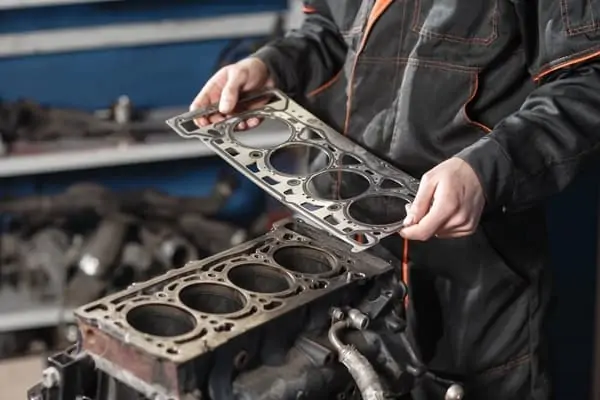Common Nissan Altima Problems Consumers Should Know About
While the Altima has proven to be a great-selling car for Nissan, there are still a few issues that have troubled consumers consistently throughout the model’s history.
In general, the Nissan Altima has proven to be a dependable and reliable car. Consumers are drawn to it for its sleek design, roomy interior, generous trunk space and outstanding fuel economy. However, as with any make or model, there are still issues that will inevitably need maintenance or repairing. So, if you’re in the market to purchase a new or pre-owned Nissan Altima, below are some common problems you should be aware of before signing on the dotted line.
If you are considering buying a used car that has under 140,000 miles and is a 2012 model or newer, get a free quote for one of our "extended car warranty solutions".
100% Online, 9 Coverage Options and No Robocalls!
Reported Nissan Altima Problems
Regardless of the Nissan model year, the most consistently reported problems specific to the Nissan Altima deal with the camshaft and crankshaft position sensors, intake gasket, fuel pump, catalytic converter, engine seal and transmission. Let’s jump into it.
Failing Camshaft or Crankshaft Position Sensor
A failing camshaft or crankshaft position sensor can cause the vehicle to not start or cause the engine to stall while the car is moving which can be dangerous. Consumers have also reported rough riding after the engine starts.
If one or both of these sensors is failing you may experience frequent stalling, reduced gas mileage, reduced engine power, or worse, the car not starting up at all. If you suspect failing sensors, you should have them tested by a professional.
If you determine that only one of the sensors is faulty, the best recommendation is to get them both replaced even though only one may be faulty. It’s a common problem that has been reported by consumers throughout the years, causing Nissan to issue a recall for this problem. Unfortunately, the recall is VIN-specific so you’ll need to call a Nissan dealership to determine if your Nissan Altima is part of the recall.
There are 24 model years that were affected beginning in 1993 and spanning through 2017, affecting mainly the 2.5L 4 cylinder and 3.5L V6 engines. As mentioned, having faulty camshaft or crankshaft position sensors can be dangerous and is a big safety issue, so if purchasing a pre-owned Nissan Altima, you’ll want to have these two sensors tested. An estimate to repair can be anywhere from $167 and $215.
Leaking Intake Gasket Affecting Air Flow Sensor
It’s common for the intake gasket to go bad in the Nissan Altimas, which affect air intake. A leaky intake gasket can lead to inefficient fuel economy, the vehicle’s engine not operating efficiently or even result in engine damage. The intake gasket is important because it allows the car’s engine to get the oxygen it needs to create the sparks within the engine cylinders that are needed to get the engine going or kick start.
The intake gasket is located between the vehicle’s air intake and the engine. When there is a leak in the intake gasket, it lets unmetered air enter the engine, resulting in an inaccurate air reading from the mass air flow sensor to the vehicle’s computer system. The computer system uses this air reading to determine how much fuel to pull in. This communication between the mass airflow sensor and the computer is what results in a great running engine. If you have a leaky intake gasket, the mass airflow sensor does not detect this air, hence the term unmetered air. And let’s not forget, because the air is unmetered, it is also polluted because it is not flowing through the air filter. To fix a leaky intake gasket can be pricey, and you can expect to pay anywhere from $311 and $387.
Failed Engine Seal
Oh no, the oil is low again? This is a commonly reported problem with the Nissan Altima, specifically the 3.5L V6 engine. After research, it has been determined that the problem is not with the oil cooler itself, but rather the actual o-rings that seal it. If the oil leakage is not detected immediately, it may cause noise to come from the engine as a result of low oil pressure. In drastic occurrences where the oil leakage is considerable, the oil level can drop to a very low level causing the Check Engine Light to illuminate with a P0011 code. Repairing the leak involves removing both the oil filter and the oil cooler, and replacing the o-ring. To replace the o-ring can be fairly inexpensive, however if both the oil cooler and o-ring need to be replaced, it could lead to a hefty bill of $680 to more than $700.
Pro Tip: If it is recommended that both are replaced, make sure to ask the mechanic why they are not only replacing the o-ring.
Faulty Fuel Pump Causing Fuel Starvation
Many consumers have complained about the Nissan Altima stalling. This complaint is most likely connected to the premature failure of the fuel pump. A fuel pump that is not operating properly leads to fuel starvation and ultimately results in the car not starting up or stalling while the vehicle is driving because it is not receiving enough fuel pressure. Without gas, your Nissan Altima will not drive.
A faulty fuel pump will lead to the car stuttering or give a sensation that it does not want to go. Sometimes it may even result in the car not turning on at all, even after repeated cranking. Both of these symptoms are a byproduct of the engine not receiving enough fuel pressure, which the car needs to get going. A prematurely failed fuel pump is most likely the culprit and has affected Nissan Altima model years consistently between 2001 and 2015. The issue did not entirely go away after 2015 because Nissan did a recall for the fuel pump on the 2019 Nissan Altima model. Bad news…replacing the fuel pump can be steep. The fuel pump itself is relatively inexpensive, but the labor involved to repair or replace it is what impacts the hefty bill. Replacing a fuel pump can range between $770 and $1160.
Catalytic Converter Failure
When the catalytic converter is failing, it causes the Check Engine Light to illuminate and possibly show the code: PO420. If you see this code, it is due to a failing catalytic converter.
Symptoms include a lack of power or fuel economy. You may not notice these symptoms immediately because they may happen over the course of time – sometimes over months, but sometimes over the span of a year! So again, this failure will not cause your car to go from a zippy ride to a car without power suddenly. But over time, it will be noticeable.
What’s happening? The catalytic converter is either clogged up or it has broken up, resulting in little pieces of debris causing the converter to clog up and operate very inefficiently. If the converter is clogged it will block the exit, not allowing the exhaust to release. The lack of exhaust release is what causes the lack of power because it is not allowing the engine to “breathe” air in and out. So, if your Check Engine Light goes off and you see the code PO420, you’ll need to get that catalytic converter checked out or replaced immediately.
Unfortunately, the cost to replace the converter can be a little expensive, but you won’t want to put it off as it is a safety issue. Do not delay…catalyst material from the converter can be sucked into the engine and cause internal damage. To replace the converter, you can expect to pay anywhere from $1160 to $1200.
Transmission
The most consistent and costly issue a buyer should know about has to do with its continuously variable transmission (CVT). Nissan consumers have been dealing with CVT transmission issues since the 2007 model. Nissan is aware of the issue and amended its powertrain warranty for model years 2007 to 2010 only to accommodate for the CVT challenges – up to 10 years or 120,000 miles. Nissan continues to be plagued with the CVT issues, forcing it to extend the powertrain warranty for many of its other vehicles from 5 years or 60,000 miles to 10 years or 120,000 miles. Keep reading to learn more about the CVT and what issues have been reported specific to the transmission.
Nissan’s CVT Transmission
Nissan introduced the CVT transmission in 2002. In the auto industry, Japanese brands tend to use CVTs more than European and U.S. brands. Nissan was an early adopter and chose to feature the CVT transmission in most of its cars and SUVs, including its best seller, the Nissan Altima.
What is a CVT?
CVT stands for continuous variable transmission. It uses a heavy-duty steel belt or pulley system which allows gears to move in a continuous, smooth motion. Unlike a manual or automatic transmission, the CVT does not have gears, leading to some benefits, such as a smoother ride. The logic makes sense – a continuously moving pulley transmission would result in a smooth driving experience. But the biggest advantage of the CVT is more fuel efficiency, which has been a long-touted benefit of the Nissan Altima, getting anywhere from 29 to 32 mpg. And because of how the pulley system is designed, it allows for a CVT-powered vehicle to accelerate with power. To many, a CVT transmission means a smooth and powerful drive.
Commonly Reported CVT Transmission Issues
Unfortunately, on the flip side, many consumers would say Nissan’s CVT transmission is extremely unreliable and can lead to an expensive repair bill. Nissan Altima owners have reported delayed throttle responses and a feeling of spasmodic movement was encountered when accelerating.
The most common reported issues include difficulty accelerating, shaking and stuttering, the engine running low and shutting down suddenly. Other issues that can be caused by the CVT transmission include loss of power, transmission jerking, transmission belt slippage, coolant hose leakage and a CVT error message. Some models even had full transmission problems. CVT transmission problems can mean a very expensive repair bill. The cost to repair the Nissan CVT transmission can range anywhere from $3,500 to upwards of $5,000.
CVT Fails and Prevention
Unlike manual and automatic transmissions, the CVT transmission does not have gears. The design of the CVT includes two cone shaped variators and a belt that runs between them. As the belt runs between these two variators, it is effectively creating gear ratios by increasing and decreasing the actual size of the belt on either end. While the CVT is less expensive to manufacture and gives you better gas mileage, they do fail on occasion. They can overheat, the bands inside wear down and break, the components of the Nissan CVT are not well made, and the pumps inside do not lubricate properly.
Here are a few tips to help prolong the life of your Nissan Altima’s CVT transmission:
- Make sure to change the transmission fluid regularly – about every 25,000 miles.
- Try not to step too hard on the accelerator pedal, meaning accelerate slowly. Remember that the CVT does not have gears, but rather a belt and pressing too aggressively on the accelerator can result in belt slippage and cause the belt to break prematurely.
- Give your transmission time to warm up – about one minute in idle. Some owners have suggested a one-minute warm up followed by driving the car “gently” another five minutes to get all the fluids properly warmed up.
- Periodically check for transmission fluid seepage. You don’t need a special visit for this, just ask for it to be checked when you have the oil changed.
- Regularly check for any TCM updates with the dealership. The TCM is the computer that controls the transmission and may need updates on occasion.
2013 Altima CVT Recall
You should know…Nissan called a recall for the 2013 Altima Transmission Control Module (TCM), which is the computer that controls the transmission. The faulty TCM was causing decreased hydraulic pressure which could lead to belt slippage under certain driving conditions. Continuing to drive the vehicle with the faulty TCM could cause accelerated wear and cause further damage to the CVT transmission. Proactively, Nissan offered to reprogram the TCM and updated the CVT software to help prevent decreased hydraulic pressure and belt slippage.
The Nissan Altima is Still a Reliable Choice
While the Nissan Altima does present some problems, so does any other make and model. And it should be noted that the Nissan Altima has proven to be a reliable and dependable car since its debut in 1993. The Nissan Altima is a well-made car. And when it comes to reliability, it shows well, scoring a 4 out of 5 on the RepairPal Reliability scale, making it the 11th out of 24 midsize cars. It also has demonstrated a lower-than-average repair cost of $483. The average of other cars in the same category average $526 for repairs.
What you can do to Minimize Risk
If purchasing a used Nissan Altima, we recommend paying for a pre-purchase inspection performed by a reputable mechanic. Consumers may also consider buying a certified pre-owned Nissan Altima to alleviate concern and minimize the risk of buying a used car.
Purchasing an extended warranty from olive® is also a good safeguard in case of the unexpected mechanical breakdown.
Other things you can do to minimize these common problems include keeping up with regular maintenance of the vehicle and addressing repairs when they happen, however small. A small repair may only be an inconvenience now, but can lead to more severe issues and a heftier repair bill later.
Cover it…olive® it
Done all your research? Ready to sign on the dotted line and ride into sunset in your Nissan Altima?
Don’t forget to cover your ride with an extended warranty. Extended warranties on pre-owned vehicles have become more critical because they provide coverage in case a repair is needed. In general, below is an example of items covered under extended warranties.
Steering System | Electrical Components | Engine Assembly | Drivetrain | Transmission | Exhaust Systems | Alternators, Manifolds, Pumps | Heating and Cooling Assembly
Introducing olive®
olive® is shaking up the way drivers look at extended warranties. For nearly 20 years our company and its affiliates have been providing coverage for vehicles in a consumer-friendly way. Get peace of mind with olive’s Mechanical Breakdown Insurance. Why Choose olive®?
- No waiting period
- Start coverage up to 140,000 miles
- No yearly mileage limits
- Coverage across the U.S.
- Manageable monthly payment options
- Cancel anytime
You can get a quote today and be covered tomorrow. Best of all, our products, customer service and reputation for excellence have earned us an A+ rating with the Better Business Bureau, and we have partnered with some of the insurance industry’s largest companies to back us. We’re in the business of helping you live life covered!






